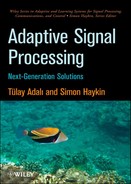CONTENTS
Chapter 1 Complex-Valued Adaptive Signal Processing
1.1.1 Why Complex-Valued Signal Processing
1.2.2 Efficient Computation of Derivatives in the Complex Domain
1.2.3 Complex-to-Real and Complex-to-Complex Mappings
1.2.5 Statistics of Complex-Valued Random Variables and Random Processes
1.3 Optimization in the Complex Domain
1.3.1 Basic Optimization Approaches in ![]()
1.4 Widely Linear Adaptive Filtering
1.4.1 Linear and Widely Linear Mean-Square Error Filter
1.5 Nonlinear Adaptive Filtering with Multilayer Perceptrons
1.5.1 Choice of Activation Function for the MLP Filter
1.5.2 Derivation of Back-Propagation Updates
1.6 Complex Independent Component Analysis
1.6.1 Complex Maximum Likelihood
1.6.2 Complex Maximization of Non-Gaussianity
1.6.3 Mutual Information Minimization: Connections to ML and MN
Chapter 2 Robust Estimation Techniques for Complex-Valued Random Vectors
2.2 Statistical Characterization of Complex Random Vectors
2.2.1 Complex Random Variables
2.3 Complex Elliptically Symmetric (CES) Distributions
2.3.3 Testing the Circularity Assumption
2.4 Tools to Compare Estimators
2.4.1 Robustness and Influence Function
2.4.2 Asymptotic Performance of an Estimator
2.5 Scatter and Pseudo-Scatter Matrices
2.5.1 Background and Motivation
2.6.3 Estimating the Number of Sources
2.6.4 Subspace DOA Estimation for Noncircular Sources
2.7 MVDR Beamformers Based on M-Estimators
2.7.1 The Influence Function Study
2.8.1 The Class of DOGMA Estimators
2.8.2 The Class of GUT Estimators
3.4.1 Basic Properties of Iterative Decoding
3.5 Forward-Backward Algorithm
3.5.1 With Intersymbol Interference
3.6 Simplified Algorithm: Interference Canceler
3.9.3 EXIT Chart for Interference Canceler
3.10 Multichannel and Multiuser Settings
3.10.1 Forward-Backward Equalizer
Chapter 4 Subspace Tracking for Signal Processing
4.2.1 Eigenvalue Value Decomposition
4.2.3 Variational Characterization of Eigenvalues/Eigenvectors of Real Symmetric Matrices
4.2.4 Standard Subspace Iterative Computational Techniques
4.3 Observation Model and Problem Statement
4.3.2 Statement of the Problem
4.4 Preliminary Example: Oja's Neuron
4.5.1 Subspace Power-Based Methods
4.5.2 Projection Approximation-Based Methods
4.5.3 Additional Methodologies
4.6.1 Rayleigh Quotient-Based Methods
4.6.2 Eigenvector Power-Based Methods
4.6.3 Projection Approximation-Based Methods
4.6.4 Additional Methodologies
4.6.5 Particular Case of Second-Order Stationary Data
4.7 Convergence and Performance Analysis Issues
4.7.1 A Short Review of the ODE Method
4.7.2 A Short Review of a General Gaussian Approximation Result
4.7.3 Examples of Convergence and Performance Analysis
4.8.1 Direction of Arrival Tracking
4.8.2 Blind Channel Estimation and Equalization
5.2 Motivation for Use of Particle Filtering
5.4 The Choice of Proposal Distribution and Resampling
5.4.1 Choice of Proposal Distribution
5.5 Some Particle Filtering Methods
5.5.2 Auxiliary Particle Filtering
5.5.3 Gaussian Particle Filtering
5.5.4 Comparison of the Methods
5.6 Handling Constant Parameters
5.6.1 Kernel-Based Auxiliary Particle Filter
5.6.2 Density-Assisted Particle Filter
5.11 Computational Issues and Hardware Implementation
Chapter 6 Nonlinear Sequential State Estimation for Solving Pattern-Classification Problems
6.2 Back-Propagation and Support Vector Machine-Learning Algorithms: Review
6.2.1 Back-Propagation Learning
6.3 Supervised Training Framework of MLPs Using Nonlinear Sequential State Estimation
6.4 The Extended Kalman Filter
Chapter 7 Bandwidth Extension of Telephony Speech
7.2 Organization of the Chapter
7.3 Nonmodel-Based Algorithms for Bandwidth Extension
7.3.1 Oversampling with Imaging
7.3.2 Application of Nonlinear Characteristics
7.4.2 Parametric Representations of the Spectral Envelope
7.5 Model-Based Algorithms for Bandwidth Extension
7.5.1 Generation of the Excitation Signal
7.5.2 Vocal Tract Transfer Function Estimation
7.6 Evaluation of Bandwidth Extension Algorithms
7.6.1 Objective Distance Measures
